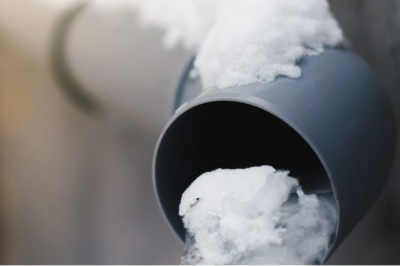All condensing gas boilers produce condensate as a waste product. There are a number of options available to the installer of how to dispose of this condensate, with some being easier for them to install while others are easier for you as the customer to manage. We show you three easy ways to fix a frozen condensate pipe.
During the cold winter months, external condensate pipes are at risk of freezing, and this can potentially cause a problem with your boiler and making it switch off as a safety precaution. This is obviously not needed any time, but especially in winter when it is more difficult to get hold of an engineer to fix the issue.

Where can condensate pipes freeze?
Condensate pipes that run externally leave it vulnerable to be frozen in extremely cold temperatures. Pipes that run through wall cavities or outbuildings such as garages that are unheated are also at higher risk of freezing. If you run your hand along the pipe externally, the coldest part will likely be where it’s blocked.
You may have seen a fault code on the boiler which indicates a problem. But before you go calling in an engineer, if you have a length of condensate pipe running outside and it’s particularly cold, check to see if the pipe has frozen. If it is, you have a number of ways to defrost them that are simple:
How do I know if I have a condensing boiler?
Condensing boilers usually have a plastic flue terminal outside of the property. When the boiler is on, there is likely to be white steam coming out of the flue, depending on the outside temperatures. Condensing boilers will also have a plastic pipe coming out of the boiler to allow waste water to be drained away.
How to thaw a frozen boiler condensate pipe
- Pour warm water on the frozen part. Usually, it’s near the bottom of the pipe. Make sure it’s not boiling water as the pipe could crack. You may need to do this a few times before the ice inside melts away.
- Use a hot water bottle. To defrost the pipe, put a hot water bottle over the affected area and let it sit there until the pipe is clear and you can see water trickling out again.
- Use a heat wrap. Much like a wrap that is used for muscular pain, you can wrap this around the pipe and it should clear the blockage after some time. It has the advantage of not slipping off the pipe so you don’t have to stay there to keep a watch.
All the above methods are very effective in fixing a frozen condensate pipe. You may need to reset the boiler again and make sure there are no fault codes once unfrozen.
Fault codes on a boiler may indicate a frozen condensate pipe
When a frozen condensate pipe is bad enough for the boiler to stop working, it will display a fault code. Before calling a repairman, check the code in the user manual to see if it’s a condensate pipe problem, it is usually listed. You can also download most of these manuals online.
How to stop the condensate pipe freezing again
It is best to prevent the pipe from freezing. If the condensate pipe is regularly freezing, you can buy pipe insulation that is waterproof and UV resistant to wrap around. If you cannot access the pipe easily or you want to change the angle or location of it, you can call an engineer to see what can be done.
How to prevent a condensate pipe freezing:
- Re-route the pipe so it discharges into a internal soil stack or internal sink or washing machine waste pipe
- Increase the fall angle of the condensate pipe so the water flows out quicker instead of trickling out
- Increase the condensate pipe diameter to 32mm if it is 22mm, this helps prevent build up of frozen water in the pipe which can lead to blockages.
All the above methods should be carried out only by a gas safe engineer as the condensate pipe is generally considered to be part of the boiler’s flue system.
*The information in this article should be used for general guidance only and not as financial or health advice. Full details are on the link in the footer to our disclaimer page. Always discuss your requirements with a competent and suitably qualified professional before undertaking any work.
Affiliate disclosure
Heatology.co are participants in a variety of affiliate schemes which help fund and run this website, visitors who follow our links and purchase a product may earn Heatology.co a commission. The money we make from affiliate marketing costs you nothing but keeps us online, so thank you for your continued support!
